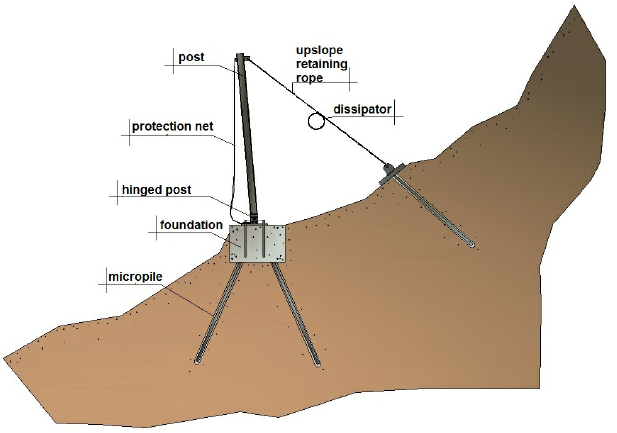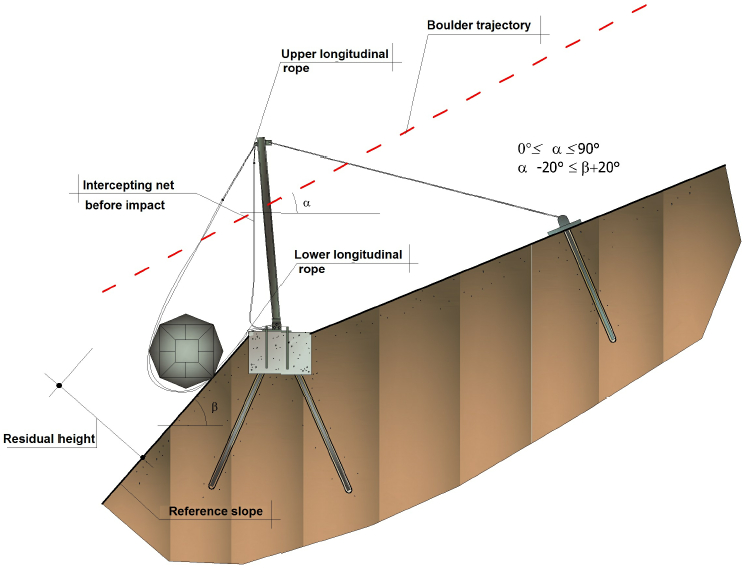The rockfall systems are protection systems having the aim of intercepting and stopping the trajectory of the rock blocks before they can damage the structures to be protected.
The barrier must have the geometrical and mechanical characteristics such as to absorb the kinetic energy and impact of the blocks themselves.
An example of a classification of these systems on the basis of the power of energy absorption is shown in the picture below.

Rockfall barriers can be classified into rigid or flexible, the second ones can be put in place, with or without retaining ropes.
The systems with limited deformability "rigid" are designed to stop the boulder in reduced spaces.
The systems which are highly deformable "flexible" are designed to dissipate large quantities of energy through a work both in plastic and elastic field.
The proper functioning of a barrier depends significantly on the sizing of the structure components. The main elements are the nets that constitute the main interception structure of the blocks, that, when deforming, dissipate the kinetic energy of the impact.
The value of the dissipated energy can be calculated using the following relationship:

where:
M |
elasticity modulus |
Af [cm2] |
area of the section of the ropes |
Df [cm] |
diameter of the ropes |
Al [cm] |
maximum elongation of the ropes |
![]()
ap [%] |
percentage elongation of the rope, generally equal to 8 |
L [cm] |
total length of a rope; |
Nf |
number of ropes involved in the impact |
The energy dissipator is a loop of steel wire rope closed by a brake element. When the boulder impacts against the net, the loop tends to slide inside the brake element, dissipating by friction a fraction of the kinetic energy of the impacting boulder. They come into operation when the absorption capacity of the net is exhausted.
The energy dispersed by the dissipators can be calculated using the expression below:
![]()
where:
|
fraction of the kinetic energy not dissipated by the deformation of the net |
||
Lc |
length of the loop |
||
Nd |
number of dissipators that come into operation |
The posts are needed to maintain deployed nets, their static function is indispensable to the functioning of the barrier, it can happen that the boulder impacts with one of the posts that support the nets, and one must verify the amount of energy dissipated in the impact and the need to predispose anchors.
The dissipated kinetic energy is given by:

with
![]()
that represents the maximum load absorbed by the post in the elastic phase
|
|
Mra [cm3] |
Modulus of steel strength |
Sa [kg/cm2] |
Steel tensile strength |
H [cm] |
Height above ground level of the post |
Ma [kg/cm2] |
Steel elasticity modulus |
Ja [cm4] |
Steel moment of inertia |
The corresponding maximum deformation of the steel is given by:

Assuming that the deformation of the posts remains in the elastic phase, the kinetic energy absorbed by the anchors will be given by:

where:
![]()
is the elongation of the rope relative to the maximum elastic deformation of the post
Mf [kg/cm2] Elasticity modulus of the rope
θ [°] angle between the anchor and the post
Na number of stressed anchors
If is taken into account the maximum deformation that can be absorbed by the ropes we get:

![]()
represents the maximum elongation supported by the steel rope
Almax [%] maximum percentage elongation of the rope
Lt [cm] total length of the rope

To verify the performance capabilities of net rockfall barriers are conducted impact tests (crash test). The normative ETAG 027 classifies rockfall barriers in eight different energy classes and for each of them there are two different energy levels.
The energy level of a rockfall barrier is defined as the kinetic energy of a homogeneous and regular boulder that impacts the net of the considered barrier.
•Energy level SEL (Service Energy Level) - the SEL test indicates the ability of the barrier to cope a consecutive rock fall events in a in rapid succession.
The barrier at this energy level must completely stop the boulder in the course of two successive impacts, must be guaranteed during the test some specific standards that we are going to list below.
The rockfall barrier passes the test for SEL if it meets the following conditions:
1° SEL launch valid if
1.The boulder is stopped by the barrier.
2.There are no breaks in the connection components (that remain connected to the foundations) in the posts and ropes. Breaking means the complete separation of the structure into two distinct parts. The mesh opening of the net can not exceed two times the initial size of the mesh.
3.The residual height of the barrier after the test (without removing the boulder) is greater than or equal to 70% of nominal height.
4.The boulder does not touch the ground until the barrier has reached the maximum elongation during the test.
2° SEL launch valid if
1.The boulder is stopped by the barrier.
2.The boulder does not touch the ground until the barrier has reached the maximum elongation during the test.
No maintenance is allowed between the first and second SEL launch. The impact energy of SEL level is equal to one third of that of the MEL level, described below.
•Energy level MEL (Maximum Energy Level), maximum energy interception guaranteed by the barrier, it must be performed an impact test during which the barrier must demonstrate to stop the boulder and meet the following conditions:
1.The boulder does not touch the ground until the barrier has reached the maximum elongation during the test.
2.The residual height of the barrier must be measured and reported according to the following classification:
a.Category A: residual height ≥ 50% nominal height
b.Category B: 30% of the nominal height < residual height < 50% nominal height
c.Category C: residual height ≤ 30% nominal height
3.The maximum elongation of the barrier during the test must be measured and declared.
4.Must be drawn up a detailed description of the damage to the barrier after the impact test ended.
In addition to the classification categories as a function of measured residual height, the rockfall barriers are classified according to the levels of SEL and MEL energy that are shown in the following table.
Energy level |
0 |
1 |
2 |
3 |
4 |
5 |
6 |
7 |
8 |
SEL (kJ) |
- |
85 |
170 |
330 |
500 |
660 |
1000 |
1500 |
>1500 |
MEL (kJ)≥ (grater) |
100 |
250 |
500 |
1000 |
1500 |
2000 |
3000 |
4500 |
>4500 |
The following two figures show the standards to which reference was made in describing the tests prescribed by the standard ETAG 027.
|
|
Actions on the foundations
The energy absorbed by the posts, by the dissipating elements and by the upwind system generates efforts on the ground that must be countered by appropriate foundation systems of the posts and upstream and downstream anchors. ETAG 027 standard requires that during the test the soliciting force on the foundation system must be measured throughout the period of impact, so it will be possible to produce a document that describes the trend of the soliciting force as a function of time.
The measuring instruments may be load cells which provide a series of readings per second, but the dimensioning of the foundation is carried out not only as a function of the loads transmitted but also as a function of the geotechnical properties of the site. As a precautionary measure would be appropriate to refer always to the worse configuration.
|
© GeoStru

